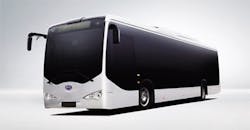Electric Buses Will Take Over Half the World's Fleet by 2025
Nearly half of the municipal buses on the road worldwide will be electric within seven years, with China expected to dominate the global market as it aims to cut urban pollution and support domestic manufacturers.
The total number of electric buses in service is forecast to more than triple, from 386,000 last year to about 1.2 million in 2025, equal to about 47% of the worldwide city bus fleet, according to a report from Bloomberg New Energy Finance (BNEF).
“China will lead this market, due to strong domestic support and aggressive city-level targets,” wrote Aleksandra O’Donovan, an analyst for BNEF and author of the study.
By 2025, the report said, the country will account for 99% of the world’s battery-powered buses.
Electric buses remain more expensive up front than those fueled by diesel or compressed natural gas, but BNEF found that battery-powered buses can already offer a lower total cost of ownership when fuel and maintenance expenses are considered. Projected declines in battery prices will make the upfront costs of some electric models competitive with a diesel version by 2026, according to the study.
Public buses are a key part of the urban transit infrastructure, and the fact that they serve routine, fixed routes makes them ideal for electrification. Cities across the globe increasingly see electric buses as a way to reduce local air pollution, and such municipalities as Paris and Amsterdam have set goals to switch to zero-emission buses in the coming years.
Earlier this week, mayors of some of California's largest cities, including Los Angeles and San Jose, urged the state's environmental regulator to introduce incentives and requirements to spur a shift toward electric buses from ones that use diesel or natural gas
China has set the most aggressive clean-energy bus-deployment targets. Warren Buffett-backed BYD Co., China's largest seller of electric vehicles, is well-positioned to take advantage of this government push.
Last year in China, BYD sold 100,183 new-energy vehicles—a category that includes full electric and hybrids), and the company’s buses now operate in 200 cities around the globe.
By Mark Chediak
About the Author
Bloomberg
Licensed content from Bloomberg, copyright 2016.
